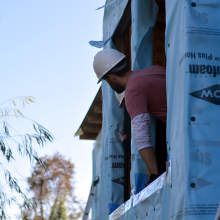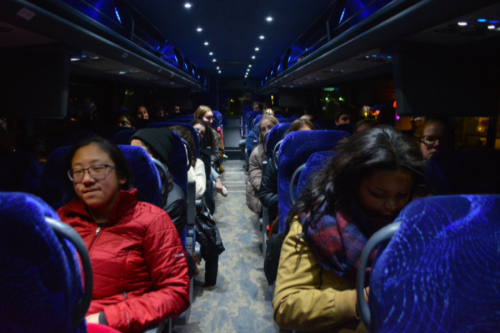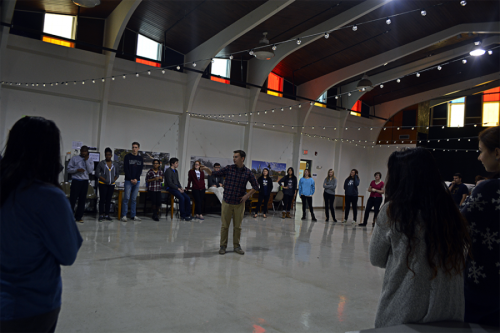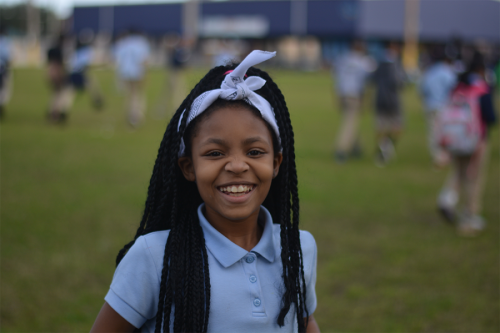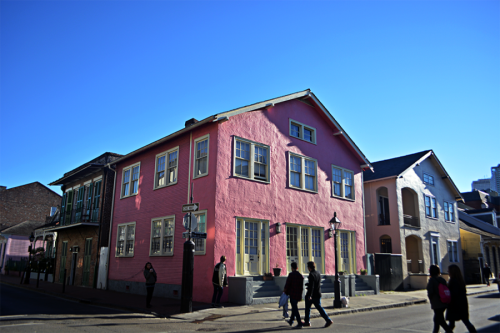During Winter Break 2015-2016, Madeleine Cook (IAC 2015-2016) participated in the GW Alternative Breaks program, spending a week in New Orleans. She shares her story of the trip.
To begin our Alternative Break, we grabbed a seatmate and climbed on a big, uncomfortable bus for twenty-two hours. We binge watched movies from the early 2000s: Mean Girls, Freaky Friday, She’s The Man. Over the next day, we would intimately get to know our seatmate; we would share snacks, have a never-ending conversation and drool on them. Reprieve came in the form of meal stops, all forty-nine of us crowding into a single restaurant. Bonding came fast and furious in this cramped, but lovely drive.
We stayed at Camp Restore in New Orleans, Louisiana. Camp Restore is a church-turned-housing for volunteers travelling to NOLA for service to the community recovering after Hurricane Katrina. Camp-style, we all crashed in bunk beds at the end of a day’s work. Camp Restore became our home for the week, and we settled into the communal shower and the chore routine quickly. Camp Restore provided us with three meals a day, comfortable beds, and space to quickly become close friends and well-equipped volunteers.
AWB NOLA began with forty-nine strangers who hardly knew one another. By the end our time together, we were a tightly knit family. The first step of becoming that family was to learn forty-eight new names. The group leaders organized fun, silly games to foster new friendships in the “big room” of Camp Restore. Games like Mafia were essential in securing the everlasting bonds that were inevitably formed during the NOLA experience. Each day after service, all of the participants would divide into small groups for reflection. Small group reflection was one of the most meaningful parts of the Alternative Breaks process. Open reflection and processing of the impact of the day’s events and service is essential to maintain the constant personal growth that thrives during an alternative break.
Brian, Cam, Elizabeth, Kait and Camille were our group leaders, responsible for logistically maneuvering and cultivating the extraordinary time that was had during AWB NOLA. Whether it was successfully ordering 50 po’boys from a roadside diner, or managing the aux cord during the day’s journeys, each leader gracefully handled the ups and downs of the trip with major success. Brian, pictured, is funky and fun, maintaining spirit regardless of circumstance. Elizabeth is bubbly and bright, unable to stop smiling and perfectly able to inject her optimism into everything. Cam is both calming and quirky, his laughter infectious and his reflection skills through the roof. Kait is the dedicated trooper, always focused and motivated. Camille is the logistical warrior, organized and focused. The five of them form a dynamic group of leaders that built up an amazing experience for a lot of GW students.
There is an extraordinary amount of history surrounding New Orleans and Hurricane Katrina that is commonly unknown. Robert Green, a survivor of the tragedy, emphasized that New Orleans had plenty of problems surrounding racial inequality and socioeconomic injustices, and that Hurricane Katrina simply exposed those tribulations bare and raw. AWB NOLA worked in the Lower Ninth Ward, the neighborhood most heavily impacted by the hurricane in 2005. This is a house that still stands broken in the neighborhood. Empty lots where houses once stood are overrun by vegetation. Many families in New Orleans were unable to handle the financial burden of rebuilding their entire home, and the government’s response in helping these families was far too slow. Less than half of the population of the Lower Ninth Ward has been restored since Katrina.
We worked for Habitat for Humanity during our time in New Orleans. They provide homes for families affected by Hurricane Katrina at subsidized costs, able to do so due to their mass amount of volunteers. For three days, we insulated a home, installed doors and windows, and stood on tall, semi-frightening to hammer in lots of nails. Ensuring hard hats were on at all times, Americorp volunteers instructed us on techniques to build a house (hammering isn’t nearly as easy as it seems). Between peanut butter and jelly breaks, we made progress on a house for a family who lost theirs a decade ago.
On the day before we returned to Washington DC, we worked with middle school aged youth through the Knowledge is Power Program (KIPP). After Hurricane Katrina, the nine public schools that existed in the Lower Ninth Ward narrowed to one. KIPP opened an academically rigorous charter school accessible to students in the neighborhoods hit hardest by Katrina, including the Lower Ninth Ward. For a full school day, we worked with ambitious students. Some of us worked in English classes, others in math or tech classes, but regardless of where we were, we had an amazing time teaching and learning from the students. We luckily went to KIPP on a “Celebration Day”, meaning the kids had a reward at the end of the day. The fifth graders I was working with had an egg toss, and this is mid-game.
After our days at the worksite, we were all released on downtown New Orleans. We thoroughly explored the French Quarter, familiarizing ourselves with every inch of Café du Monde while we devoured our beignets. Some of us had our palms read in front of St. Louis’s Cathedral, or strolled by the Mississippi River. We tried gumbo, jambalaya, and gorged fresh seafood. New Orleans is rich with a culture unique to anywhere else in the States, and to be privy to that for a week was an incredible experience. Not only did we experience the community, but we were fortunate enough through GW’s AB program to be able to give back to it through service.


